If you live in South Korea and are building your family, chances are that you will come across the painful conversation of having to shell out millions of wons for a post-natal facility, called Sanhoo-joliwon (산후조리원) that I will shorten to joliwon for simplicity. These facilities are quite unique to South Korea and are used by all the couples who can afford them. Women enter the joliwon after giving birth for two to three weeks before heading home. Nurses take care of babies and recovering mothers 24/7 while husbands can go and work freely.
In this article, I want to talk about my experience in hope that it will help anyone looking for more information on the subject to make up their mind. Acceptation was a long challenging process and I think that exposing my thinking evolution will offer a shortcut for those in doubt. I will quickly explain more about the history of Joliwons, what services they offer, how much they cost and the most important part, in my opinion, the right conversation to have with your partner about them. If that last one is what brought you here and you are boiling in anger over this, then I would advise you to jump over to the “The Wrong Conversation and The Right Conversation” section of this article. It will ease your conscience and open your mind to the rest of the article.
Hold onto your boxer shorts, this is going to be a long one.
My State Of Mind At The Start
I am originally from France where there is no such thing as post-natal facilities. Couples come into the hospital to give birth, they come out the next day or a couple of days later depending on each individual case. Recovery and learning to take care of the baby is done the hard way with sleepless nights and nerve racking arguments. So when the subject came up once while speaking as a guest on a radio show, my participation to the conversation was short and sweet: this is nonsense, we’re not spending that much money for something that is not essential. Then came the reason why they were so popular: Korean bodies are different and therefore joliwons are actually essential for recovery.
I can’t swear on radio. If I could’ve, I would’ve.
No need to tell you that I was not sold on the idea. Instead, I was fighting a raging war against it as its selling point was entirely based in ignorance. I do not like unintelligible ignorance and decided to not tolerate it in my own house. We all remember the PR disaster when a Korean brand tried to sell the idea that Korean intestines are shaped differently compared to the rest of the world.
That being said-
History of Joliwons
The first post-natal clinic was opened in 1997 in Seoul. It was a new business developed by birth clinics to bring in some more income. It was based on the Korean concept of the 37 days which is considered the length of time necessary to take care of the mother and the baby after birth.
Within 3 years following the opening of the first post-natal center, 400 more opened. It offered two main tractions: it was very helpful for mothers and babies, and it increased the employment of middle-aged women who took care of the babies. It was fairly unregulated, however, and anyone could get a job there. Also, some of them offered only tiny rooms coupled with shared showers and bathrooms. This was all cut short in 2001 when three babies didn’t survive enteritis (intestinal inflammation). Following that, 120 centers were closed.
In 2006, a new law passed requiring that all staff working in joliwons must have nursing licenses and in 2007, during the gold pig year, business picked up and joliwons became popular again. The pig, in Eastern culture, is representative of fortune and money. This was a good time to use money to help babies come into the world in comfort.
It became very popular, especially with the message about how “Korean bodies are different and thus require joliwons to recover after giving birth.” Koreans who grew up in this world where joliwons are now common place took this message for irrefutable truth and they now can’t imagine giving birth and not use this facilities.
Now that you know the truth, you can tell you precious partner who holds tight on this belief that the centers are just twenty years old.
There is something to be said about their popularity, however. As of 2017, there are now 600 centers in Korea alone and more can be found in China and Taipei. I wouldn’t be surprised to see the trend grow beyond that over time.
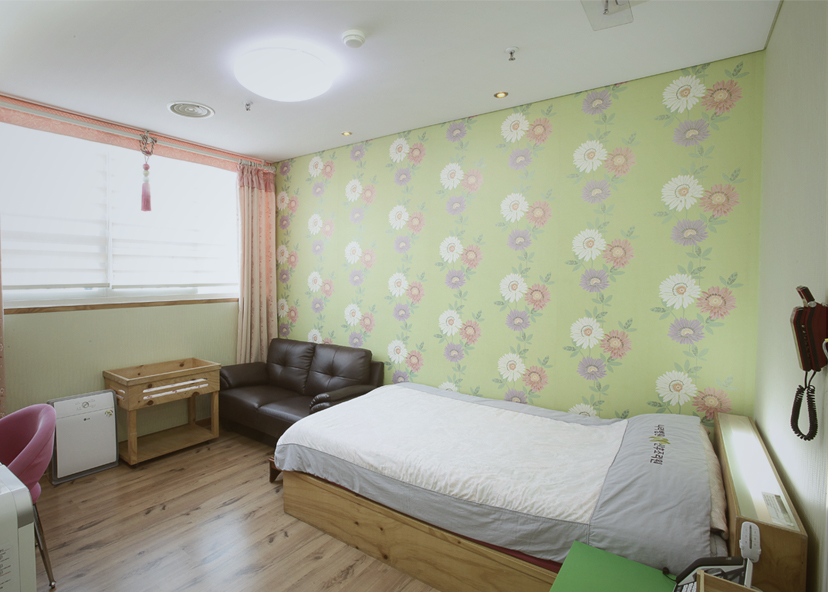
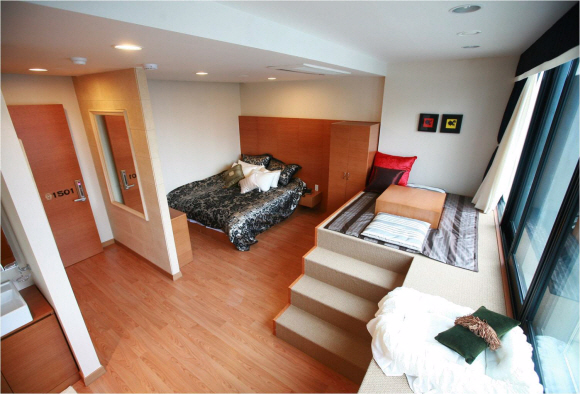
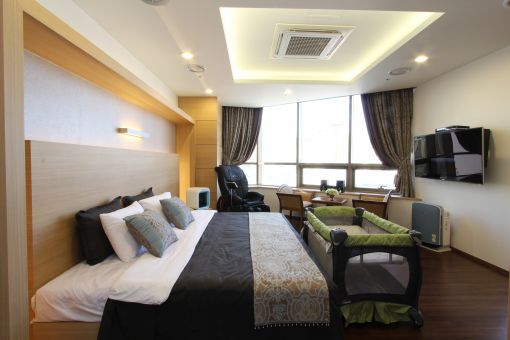
There is a wide range of different rooms available.
What do Joliwons Offer
All joliwons have different specific services so I will only go over the most common ones. First off, they offer individual rooms for mothers to rest. Some will have a double bed so that the dads can stay overnight and some won’t. Babies are kept in a separate, sterilized room where nurses take care of them 24/7. Most of them do not let family members visit during your stay but some, such as one that we visited, have the sterilized room front and center so that family members, and anybody else really, can see the babies through the window during visiting hours. Also, the babies are mostly kept inside the sterilized room except for parents time which varies from one establishment to the next. During that time, the parents keep the baby in the room with them.
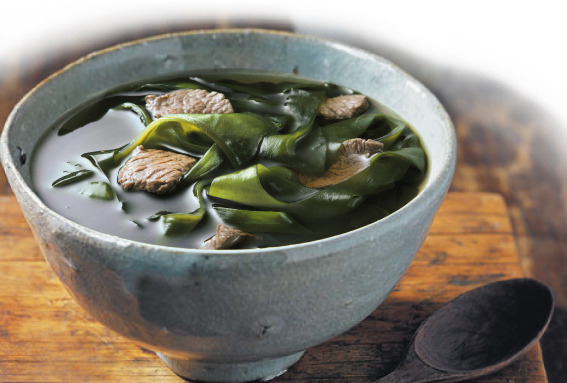
Joliwons also offer healthy food for recovery that includes the inevitable seaweed soup (미역국). Recovering mothers, may it be inside the hospital, the joliwon or at home, all eat this soup after giving birth. My critical mind tends to kick in when I hear about the miracles of seaweed soup but I must say that we have a similar dish in France used for recovery, the cabbage soup. It doesn’t taste great, you become a gas factory but apparently it has lots of great recovery-related properties.
Next, most joliwons offer education services such as how to bathe the baby, how to do simple massages, mobile building workshops, mother’s breast care-that helps for breastfeeding-, how to pump the milk, and sometimes specialized cooking for the baby.
Finally, some other services include breast massages for the mothers to release the tension created by accumulated milk, basic body massages, traditional medicine (한약) and on-site counseling.
Another critical set of services are the paying ones. Those include extra massages, baby photos and food for the father-since only the mother’s meals are included in the price-.
How to Choose a Joliwon
When going Joliwon hunting, we visited three that were selected by my wife for their proximity to both our house and the hospital, as well as their general reputation. Those were three very different experiences and here is what I will say off the cut: trust your guts because they will give you all the information you need for your comfort. Yes, this is all about comfort since your partner and potentially yourself will spend two to three weeks in that place. At that time, you have ridden the emotional roller coaster of a birth and will be in need of a quiet, comfortable place to adapt to your new situation. When we visited the first location, we walked past the front door and my first thought was “no, it’s not here right?” From outside, it looked like the entrance of a jimjjilbang: large counter, bright light and the bright marble common to most of these establishments.
At first sight, my guts told me no, but we were there so we had to at least see what services they offered and at what cost. That’s when the gimmicks kicked in. We had to enter a first tiny room where we were sprayed with jet wind coming from the sides to remove the dust from outside before being allowed to step into the lobby. Here is the kicker: you walk in, they close the door, spray you with air and then open the second door. The dust you supposedly had on you was not sucked out, it was instead free to follow up and fly into the joliwon. The angry voice in mind started to act up. Next, we had a to change our shoes, get sprayed without who knows what and wear white gowns above our apparently incredibly dirty clothe. Then, came the sales pitch. The person who took care of us showed us the room and then sat us down in the sales office with a very well organized book that had all the assets of the sales funnel justifying why we should spend two months of our salary on their establishment. And while her hand was reaching deep into my wallet through my very sensitive rectum, she didn’t dispense a single glance in my direction, not a single one, keeping her entire attention towards my wife.
Thirty minutes is a very long time when you try and contain a primal urge to scream at someone.
So yea, your guts, they know when you had too much to drink, they know how hard that break up with your first love hits you and they sure as hell know how to choose a joliwon. Funnily enough, while researching for this article, I found out that all the images that come up when typing that specific joliwon name in English in my search engine were snakes, spiders, etc.
I will spare you the second visit which was just as bad but for different reasons irrelevant here. As for the last one, the one we picked, it benefited from the two previous experiences and became a small piece of heaven right from the start. Here again, the visit itself is irrelevant. All you need to keep in mind is that every couple is different and has different needs so make to ask the questions that will confirm that you will get what you need.
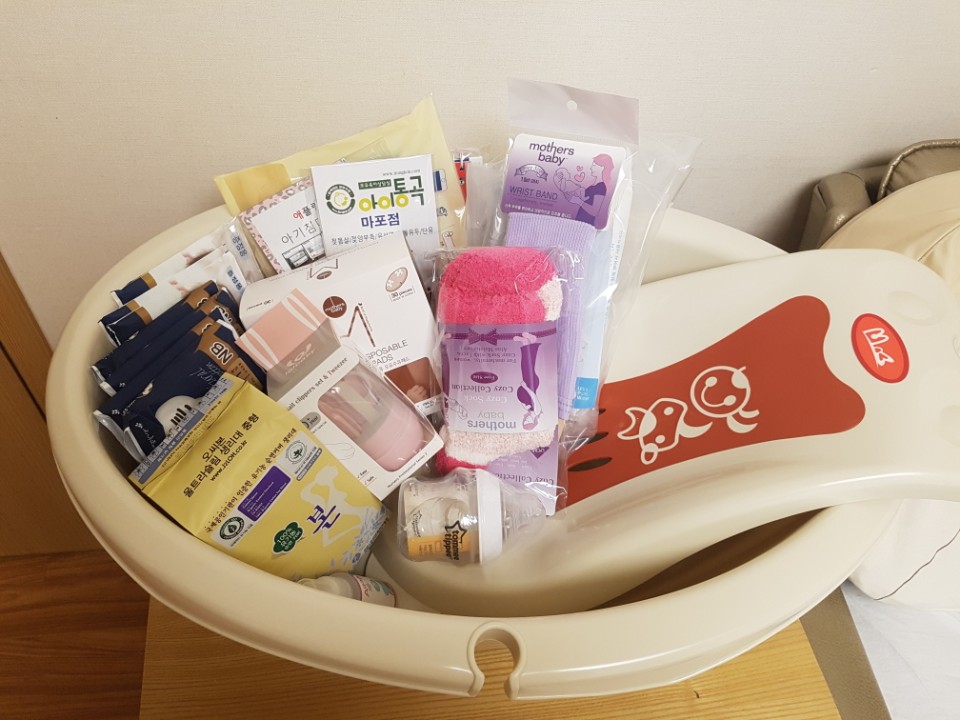
Some Joliwons provide some nice presents for you to take home.
For instance, for my wife’s specific health requirements, we needed an air purifier in the room and softened water for the shower. We found those in the joliwon we picked. It was also a relief to learn that our joliwon had a good working relationship with the hospital where my wife gave birth, making transfer and nurse visit more convenient. Also, each bed inside the sterilized room had an I.P camera above the bed. This was especially great for me as I wanted my parents to be able to see the baby from overseas as well as giving me a chance to see her while I was working. Finally, that specific establishment welcomes mix couples every once in a while which greatly reflected in the way the sales person dealt with us. She was kind and constantly involved both of us in the conversation. She did not assume that me not being Korean meant me not speaking Korean. And as it turned out, all the staff working there were equally welcoming.
My gut was ready to spend the money.
TIP: book your joliwon six months in advance. All of them fill up very quickly.
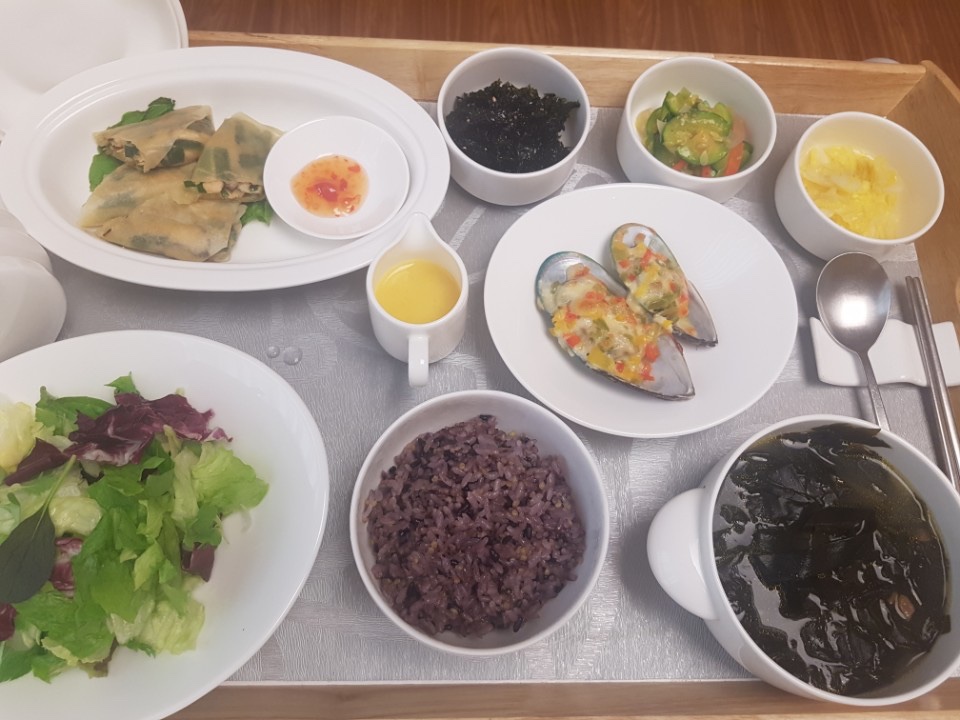
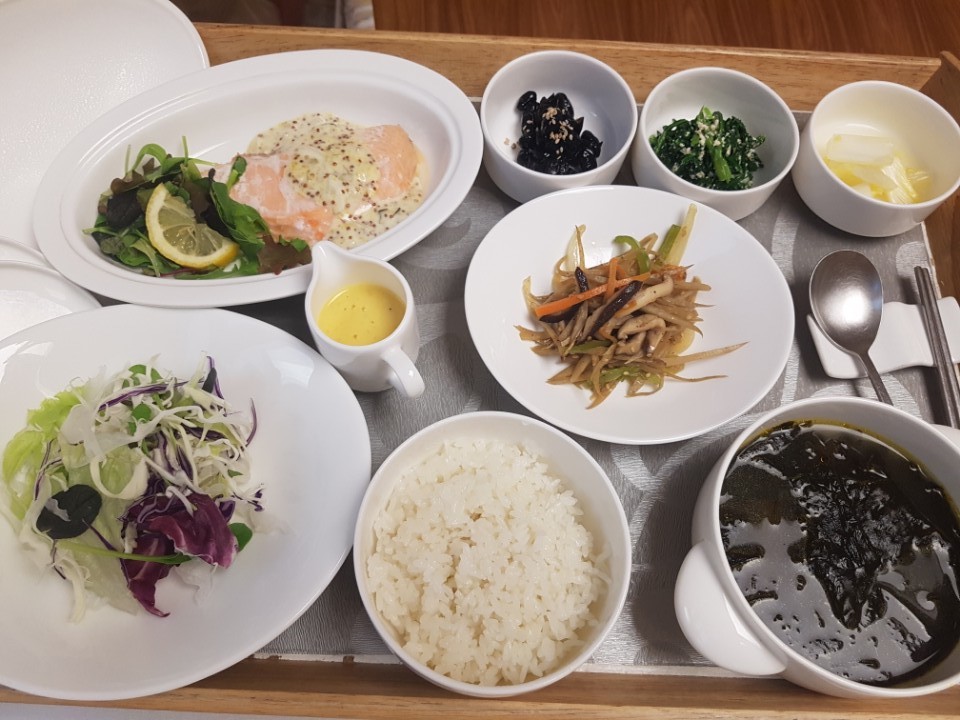
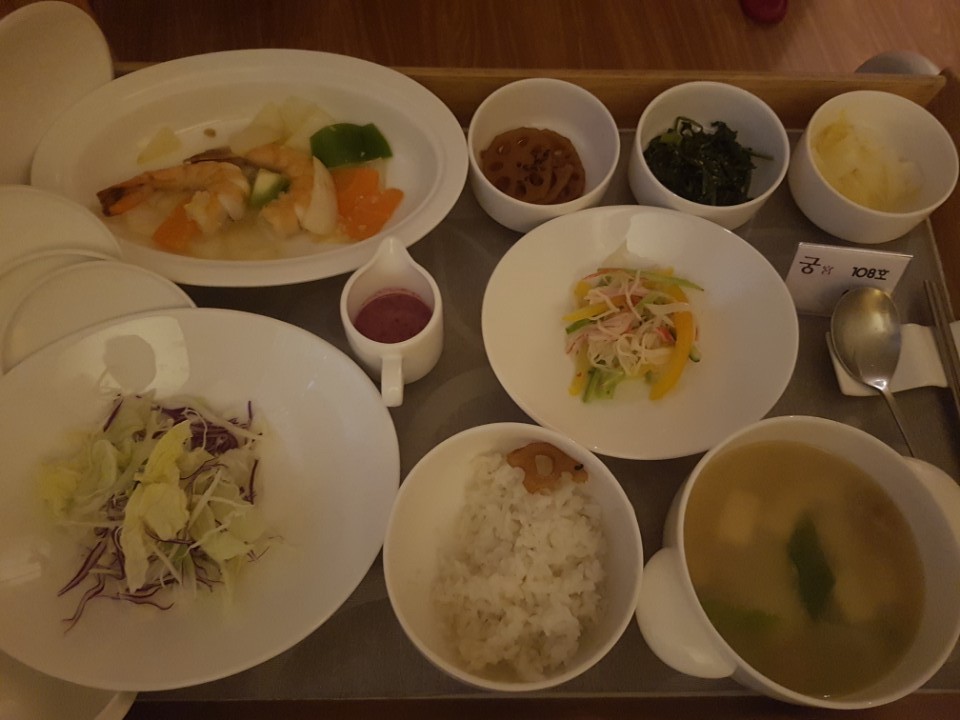
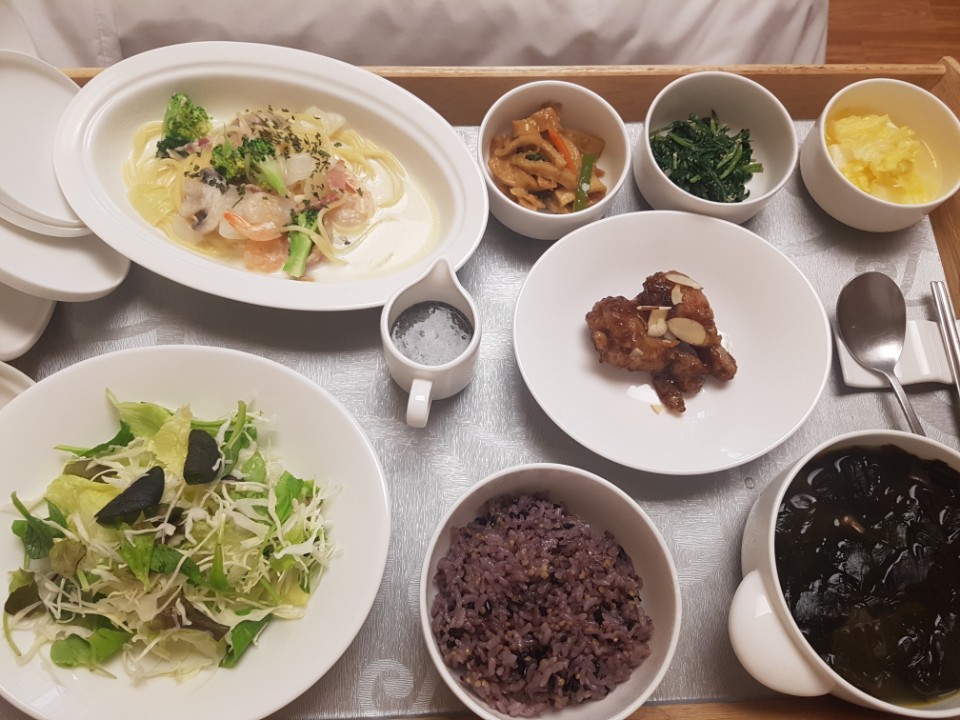
This is the actual food my wife received at the joliwon. Not too shabby!
How Much is a Joliwon
Now, that is where it hurts, really bad. The blend truth is: joliwons are very expensive, there is no way around it. Most are priced between 2 and 5 million wons (2000~5000 USD) without the extras. The one we picked was a little north of 3 million for two weeks plus some extra massages that my wife wanted and a few extras while staying there. We’re around the 5 million mark in total just for the post-natal clinic.
Those are usual prices in Seoul.
You can probably find much cheaper places outside of Seoul but as a freelance writer, my home office is indeed at home and as I was working on several projects at that time, I needed to be able to access my supporting documents inside my home office while my wife was at the joliwon. So, Seoul it had to be.
We were lucky as we had to move out from our house at the beginning of the pregnancy and found a cheaper place to live in. We got some money back from our house deposit and used it to pay for most of the birth costs. Not everyone has that luck.
So how do you start to decide if you’re gonna go for it or not? You need to have the right conversation.
The Wrong Conversation and The Right Conversation
The wrong conversation is the one I mentioned earlier, the one where Korean bodies are different from other countries bodies and joliwons are essential to the birth process. If this makes you angry the way it did to me, then you have to cut this specific conversation short and change the frame of thinking.
Move away from the ignorance and start talking about the actual benefits of staying there. If it is your first child, you will hear everybody with kids around you tell you: you will see, you will be tired, haha, no more nights, your life is going to change, etc. In short, they will all be condescending [insert whatever kind insult you have for your friends]. Apparently, parenthood does that to you. But this is still true, having a child is tiring and women have a buttload of shit heading their way, the kind of things that they don’t really tell women just to make sure that they continue to procreate. We’re talking pain, organs moving around, blood, lots of it, pains in places they didn’t know pain existed, swelling of the legs and feet and intense fatigue. For the most unlucky ones, baby blues hits and then it’s a lot of crying for inexplicable reasons.
Is there a way to make an easier transition from party-hood to parenthood? Yes, joliwons, that’s what they do. They take you from one point to the next in a softer, more humane manner than if you did everything by yourself. And keep this is mind: when I say by yourself and you are the one that keeps on working in order to bring in some money, know that you have the best end of the stick.
Now, if you need more reasons, let’s get more specific. My wife needed to give brith through operation instead of natural birth, again for health reasons. When she came out of the hospital, she was in no shape to take care of a baby. She had a painful scar and I was working. As a freelancer, I can get some flexibility in my schedule but I can never really stop working. Having her surrounded by a group of professional nurses made it so much easier to go to work in the morning. I could just call during the day and check on her every once in a while. On top of that, we needed to check my wife’s temperature every two hours as she developed a fever and the nurses on hand did it without missing a beat.
So here is the right conversation to have in your couple: will it help the transition, will it help the recovery, will it help the peace, to which it is an all around yes, yes and yes.
As you can tell, my mind has greatly changed.
The Counter Arguments
Women since the dawn of time have been given birth without post-natal facilities, why should they need one now?
Sure but If they were given the possibility to use the services of a joliwon, don’t you think they would have taken it in a heart beat?
My wife has her parents here, they can help.
Nice way to divert the responsibility on other people. Culturally they will help but they are not nurses and they had to raise their own kids long ago, give them a chance to enjoy their silver years.
It is too expensive.
That’s the tough one because yes, it is VERY expensive. So let me tell you what really put my mind at peace with the whole pricing situation. About 4 weeks prior to the operation day, one of our doctor’s assistant sat down with us and explained the procedure. She started by drawing three layers that represented the skin, the muscle layer and then the outer part of the uterus. The drawings were basic but it was easy to make a clear picture in our heads of what they represented. Then, she drew a basic blade and explained how each layer would be cut on a length of 10 cms. Then, the baby would be pushed through the hole with some extra pressure on the belly in case it doesn’t come out easy. Once this baby, 3.4 kgs of it, it turned out, has finally come out of the makeshift hole, each layer would be sewed one by one. All of it while the mother is fully awake and listening to the doctors conversation as only the lower part is anesthetized.
At this point, let me be clear, she could get all the joliwons she wanted, my sole job was to find the money.
Other Testimonies
While writing this article, I asked a few other dads what they thought about the joliwons. The opinions were unanimous: it was very helpful. Although experiences vary, most say that the nurses were helpful and the places were quiet and comfortable. All say it helped for recovery.
Some mentioned that the education was key while some others may have felt left out when the nurses would take over the care of the baby without explaining or teaching anything. Others said that the general philosophy of the place when it came to feeding didn’t match their own ideas. My own experience was quite excellent as the nurses not only asked us what we preferred, matched their schedule and feeding requirements to my wife health needs and we could have the baby with us anytime we wanted.
Everyone agrees that it is pricey, no surprises there.
Conclusion
I can’t tell you what is best for you and your family but here is what I can tell you: have the right conversation with your partner and look at the facts. If you’re not the one with 3 kgs of baby coming out of you, if you don’t get your belly sliced, if your body doesn’t swell and your organs are not pushed around and then need to find they original space while a baby is sucking on your cracked nipples, then it’s not really up to you.
Continue the Conversation
If you have any questions or want to start a one about this issue, you can do so in the comments here but I am not sure that it is the most efficient way to do it. Feel free to reach out on twitter at @AurelienLaine and I will be happy to answer any question. I understand the rage that arises through a lot of these painful processes and I can provide a word of wisdom or two. Can’t quite stretch it to three I’m afraid.
Happy joliwon hunting and congratulations, you’re going to be a parent!
-
RT @ScalesRed: Congratulations @ErasmusDekker! You are the winner of the #koryohallofadventures giveaway contest. I will be in tou… https://t.co/IWJyI4rHZl
-
We’re now over 1,000 entries on the contest and over 37,000$ on the #kickstarter campaign! Less than 500 entries an… https://t.co/BMsO68wAeK






